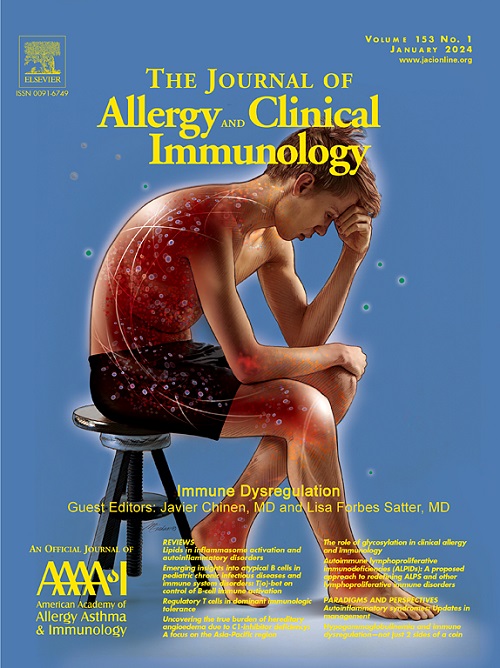Opsin 3 in keratinocytes mediates the light-induced exaggeration of atopic dermatitis
IF 11.2
1区 医学
Q1 ALLERGY
引用次数: 0
Abstract
Background
Atopic dermatitis (AD) is a common chronic inflammatory skin disease often exaggerated by sun exposure, whereas sun-exposed regions are usually spared from psoriasis. Opsin 3 (OPN3), a photoreceptor, has been implicated in nonvisual functions of the skin including skin pigmentation and barrier restoration. However, whether OPN3 engages in light-induced inflammation of AD remains unclear.
Objective
We sought to explore the role and mechanism of OPN3 in light-induced exaggeration of AD.
Methods
The expression of OPN3 was assessed by reverse transcription quantitative PCR, western blotting, immunohistochemistry, and immunofluorescence. The roles of light and OPN3 in type 2 inflammation were evaluated in mouse models and cultured keratinocytes (KCs). The mechanisms by which OPN3 regulates light-induced inflammation in KCs were examined by bulk RNA-sequencing, ELISA, calcium imaging, and immunofluorescence.
Results
We found that OPN3 expression was increased in KCs of skin lesion from patients with AD and MC903-induced AD mouse model, but not patients with psoriasis or imiquimod-induced psoriasis mouse model. Type 2 cytokines induced OPN3 expression in KCs, which upregulated the production of proinflammatory cytokine IL-36γ, TNF-α, IL-8, and IL-1β. Notably, light exposure exaggerated skin inflammation in mouse model of AD, but not psoriasis. Moreover, light triggered the production of proinflammatory cytokines in KCs through OPN3-mediated calcium influx and sphingosine 1-phosphate-sphingosine 1-phosphate receptor signaling.
Conclusion
OPN3 plays a microenvironment-specific proinflammatory role in KCs upon light exposure, and may serve as a candidate of therapeutic targets for AD.

角化细胞中的视蛋白3介导光诱导的特应性皮炎的加重。
背景:特应性皮炎(AD)是一种常见的慢性炎症性皮肤病,常因日晒而加重,而日晒区通常不会发生牛皮癣。视蛋白3 (OPN3)是一种光感受器,参与皮肤的非视觉功能,包括皮肤色素沉着和屏障恢复。然而,OPN3是否参与AD光诱导炎症尚不清楚。目的:探讨OPN3在光致AD加重中的作用及机制。方法:采用反转录定量PCR、western blotting、免疫组织化学、免疫荧光法检测OPN3的表达。在小鼠模型和培养的角质形成细胞中评估光和OPN3在2型炎症中的作用。通过大量RNA测序、ELISA、钙成像和免疫荧光检测OPN3调节角化细胞光诱导炎症的机制。结果:我们发现OPN3在AD患者和mc903诱导的AD小鼠模型皮损处角质形成细胞(KCs)中表达升高,而银屑病患者和吡喹莫德诱导的银屑病小鼠模型中表达不升高。2型细胞因子诱导KCs中OPN3的表达,从而上调促炎细胞因子IL-36γ、TNF-α、IL-8和IL-1β的产生。值得注意的是,光照会加重AD小鼠模型的皮肤炎症,但不会加重牛皮癣。此外,光通过opn3介导的钙内流和鞘氨醇1-磷酸(S1P) - S1P受体信号通路触发KCs中促炎细胞因子的产生。结论:OPN3在光照射KCs中具有微环境特异性促炎作用,可能是AD的候选治疗靶点。
本文章由计算机程序翻译,如有差异,请以英文原文为准。
求助全文
约1分钟内获得全文
求助全文
来源期刊
CiteScore
25.90
自引率
7.70%
发文量
1302
审稿时长
38 days
期刊介绍:
The Journal of Allergy and Clinical Immunology is a prestigious publication that features groundbreaking research in the fields of Allergy, Asthma, and Immunology. This influential journal publishes high-impact research papers that explore various topics, including asthma, food allergy, allergic rhinitis, atopic dermatitis, primary immune deficiencies, occupational and environmental allergy, and other allergic and immunologic diseases. The articles not only report on clinical trials and mechanistic studies but also provide insights into novel therapies, underlying mechanisms, and important discoveries that contribute to our understanding of these diseases. By sharing this valuable information, the journal aims to enhance the diagnosis and management of patients in the future.

 求助内容:
求助内容: 应助结果提醒方式:
应助结果提醒方式:


